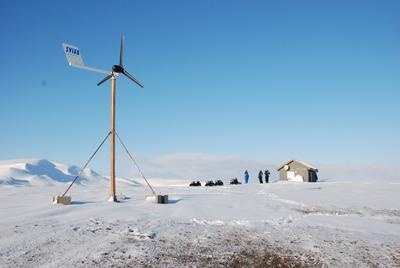In the past three years, seismic waves that pass through the ground near Longyearbyen in the Adventdalen valley, Svalbard, Norway, have steadily slowed down most probably because of permafrost warming in the Arctic valley.
 The site of the SPITS array, Svalbard. Image Credit: NORSAR.
The site of the SPITS array, Svalbard. Image Credit: NORSAR.
This trend has been described in a new study published in the Seismological Research Letters journal. The study shows how seismic monitoring can help track permafrost stability under global climate change. It has been published as part of a focus section in a forthcoming issue of the journal on Arctic and Antarctic seismology.
During her tenure in NORSAR (Norway), Julie Albaric from the University of Bourgogne Franche-Comté and her colleagues employed data from a range of seismic networks and active seismic experiments to know more about the seismic environment of the Adventdalen valley of Svalbard, as well as to gain more insights into the dynamics of permafrost in the region.
The researchers could detect seasonal variations in the seismic wave velocity and attribute this to the variations in the ice content of shallow (2–4 m deep) permafrost. Seismic waves tend to travel faster through solid materials such as ice and rock, while moving slower through softer or more liquid materials.
Shallow permafrost is susceptible to seasonal temperature variations, accounting for the seasonal changes in seismic velocity as revealed by Albaric, Daniela Kühn, and the team at NORSAR. However, the researchers observed a linearly decreasing trend in the velocity between 2009 and 2011, following the analysis of data from a permanent seismic network in the area, which showed an increasingly melted permafrost layer.
To our knowledge it’s the first study showing this long-term velocity trend. Our study demonstrates that it is worth maintaining permanent observatories, such long-term data collections are precious, and that options for data use may turn up that were not the focus of the original installation.
Julie Albaric, University of Bourgogne Franche-Comté
The team has been seeking ways to monitor permafrost since its stability has crucial implications for the global climate, with a vast melting potential causing an increase in the emission of greenhouse gases.
Seismic monitoring can serve as a robust tool in the detection of permafrost changes, particularly when the data are recorded continuously in contrast to a few other geographical techniques.
“In addition, seismic methods are very sensitive and depending on the network geometry, they allow us to target different depths and to cover large areas, allowing us to extend the very localized observations provided by borehole temperature measurements,” added Albaric.
The ambient seismic activity noise on Svalbard includes body waves that move through the interior of the Earth together with intermittent surface waves that emerge when the average temperature goes above the freezing point. The researchers note that these surface waves could have a cryogenic origin.
According to Kühn, the harsh conditions of the Arctic make it hard to deploy, maintain, and retrieve data from the networks.
In the summer, for instance, the valley fills with a broad, braided river that limits where permanent seismometers can be installed. In the winter, cold temperatures, snow and ice are harsh on equipment and shrink the time when power can be supplied by solar panels.
Daniela Kühn, NORSAR
“Meteorological conditions obviously make field work challenging, particularly when installing the stations and using a keyboard without gloves at temperatures below −30 °C,” concluded Albaric.
Journal Reference:
Albaric, J., et al. (2021) Seismic Monitoring of Permafrost in Svalbard, Arctic Norway. Seismological Research Letters. doi.org/10.1785/0220200470.